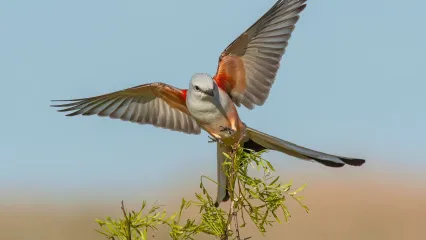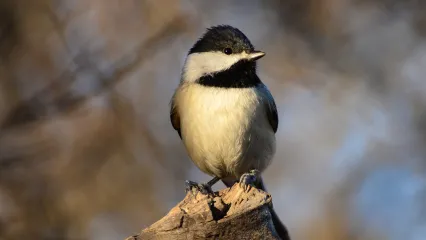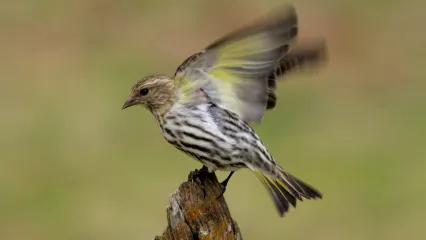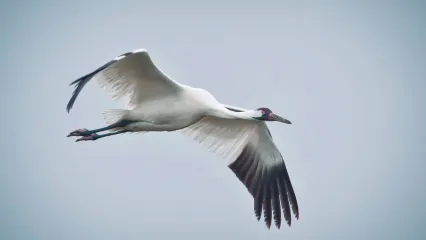
Description
Scissor-tailed flycatchers are easily identified by their long, scissor-like tail, which may reach nine inches in length. During flight, the bird opens and shuts its tail like a pair of scissors and folds or closes the “scissors” when perching. Since the bird is only 11-15 inches long, its tail is proportionately longer than any other Oklahoma bird. The nape of the scissortail’s neck and its back are pearl gray, and the breast is white. Wings are sooty black with a touch of scarlet at the shoulders while the sides and wing linings are pink. Females usually are shorter than males because her tail is not as long. Immature birds resemble adults, but their tail is shorter and only slightly forked. Scissortails utter a kingbird-like twittering while flying, clucking and chattering erratically. Their call sounds like “cah-kee…cah-key…CAH-KEY.”
Size
Approximately 8.7 to 14.6 inches long.
Habitat
In Oklahoma, scissortails often are seen in open prairies dotted with trees and along tree-lined country roads. They also appear in open country around ranches and even small towns, where they perch on telephone lines, flagpoles and fences. In rural areas, the birds will perch for hours along roadsides on fences, limbs and isolated trees. Scissor-tailed flycatchers are considered Neotropical migrants – birds that spend their winters in Central and South America, returning to North America to nest and raise young. Their limited nesting range is primarily concentrated in the Southern Great Plains states, from New Mexico to Louisiana and Nebraska southward to southern Texas and adjoining areas of northern Mexico. However, the birds have wandered as far north as Hudson Bay, as far east as New Brunswick, and as far west as Colorado. The birds winter in the southern half of Florida and the Florida Keys, in south Texas, Mexico and Central America. The birds are common winter visitors to Guatemala at altitudes under 5,000 feet.
Life Cycle
Scissor-tailed flycatchers are acrobatic foragers; birds often dart from their perches into the air in pursuit of flying insects such as bees and wasps, or drop to the ground to capture grasshoppers and spiders in the grass. They consume a greater proportion of grasshoppers, crickets and other ground-dwelling insects than any other Oklahoma flycatcher. At times grasshoppers may comprise more than 50 percent of their diet. Flycatchers are unable to digest the wings, legs and other hard body parts of their insect prey and periodically regurgitate these items as a small pellet. Some small fruits and berries also are eaten, especially in winter.
Soon after the birds arrive in the state, males begin their famous “sky dance,” a popular sight along roadsides during spring and early summer. This elaborate courtship display is performed by the male to attract the attention of potential mates. After climbing to about 100 feet in the air, the male makes a series of v-shaped flights. He soars rapidly up through the air and then plunges down in an erratic, zig-zag course while uttering a rolling, cackling call. His graceful actions are further accentuated by his long, flowing tail. This performance has been described as “an aerial ballet of incomparable grace” and may be performed all through the summer.
When courtship is over, the female constructs a bulky, cup-like nest from 7-30 feet above ground on a horizontal limb or fork. Isolated trees often are used for nests, including hackberry, mesquite, elm, oak and orchard trees. Nests also are built on windmill towers and the crossbars of utility poles. The 4 ½- to 6-inch diameter nest is formed of weed stems and cotton, and is lined with rootlets, horsehair and other soft materials. Nesting behavior follows that of most songbirds. Only one egg is laid each day, usually during the morning, and the female will not begin incubating until the last egg of her clutch is laid. She lays four to six eggs, often raising two broods during the summer. Eggs are cream-white with some spots and brown blotches. Incubation activities are conducted solely by the female, although the male may occasionally sit over the eggs to hide them or protect them when the female is off the nest. The male scissortail’s primary duties are to guard the territory from intruders and predators and to catch food, which he brings to the incubating female. The female develops a brood patch on her breast during the breeding season. This patch is devoid of feathers and allows for a more efficient transfer of the female’s body heat to the eggs. After an incubation period of 12-14 days, the eggs hatch. The young scissortails grow rapidly and are ready to leave the nest after another 14 days.
Shortly after the first brood leaves the nest, the female will build a second nest and lay a new clutch of eggs white the male tends to the fledglings from the first nest. Young scissortails remain in their parents’ territory for an additional two to three weeks after leaving the nest, when they learn to hunt for food. The young can be identified because their tails tend to be shorter than the adults’ during the first summer. When they first leave the nest, their tail feathers are not much longer than those of other flycatchers and the young closely resemble western kingbirds.
In late August, after the breeding season, scissor-tailed flycatchers begin gathering in the evenings in roost trees. The number of birds at these roosts increases gradually until they peak in late September. More than 1,000 birds may gather at a roost; however, most contain between 100 and 300 birds. The birds fan out in all directions from the roost to search for food during the day, returning just before dusk. During the breeding season, males also leave the nest tree at dusk to join other males and unmated females at a common roost tree, returning to the nest the following morning. Roosts most often are located in mature trees in isolated groves along streams or occasionally in towns. They often are used for several years in succession, with some roosts known to be used in excess of 20 years. During October, the number of birds returning to the roosts gradually drops as the scissortails begin their fall migration. Like most songbirds, scissortails migrate at night. The daylight hours are spent resting and feeding to build the fat reserves that will sustain them during the next night’s flight.
How To Observe
As a rule, scissortails are seen in Oklahoma from early April to late October, though individuals occasionally are seen during the last week of March and some birds linger until mid-November.


